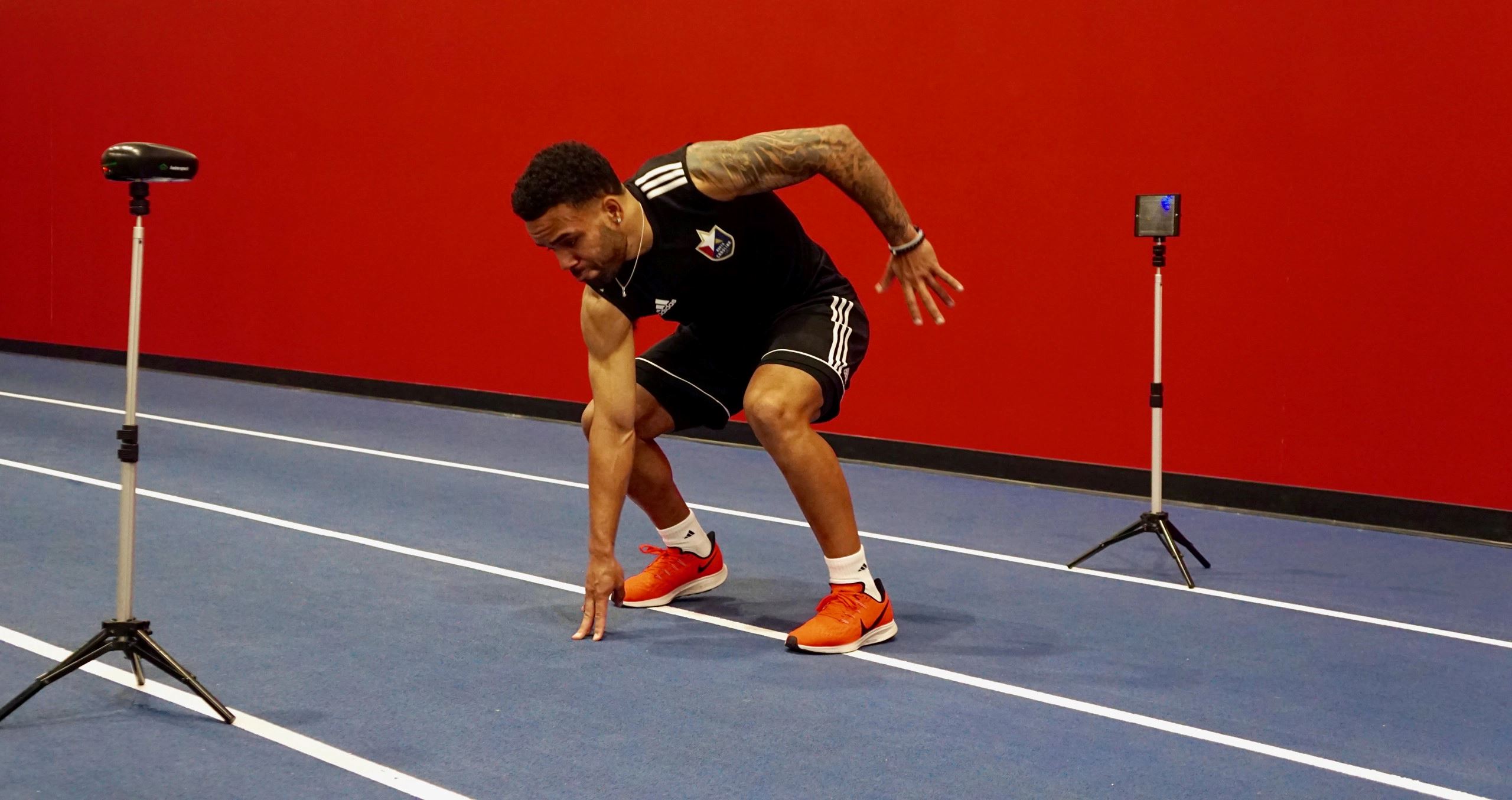Home>Misc>Featured>Why Is Cardiovascular Fitness Important In Football


Featured
Why Is Cardiovascular Fitness Important In Football
Modified: August 21, 2023
Improve your football performance with featured cardiovascular fitness. Discover why cardiovascular fitness is crucial for success on the field.
Introduction
Football is a physically demanding sport that requires a combination of skill, strength, agility, and endurance. While technical abilities and muscular strength often take the spotlight in football, cardiovascular fitness is equally important for success on the field. Having good cardiovascular fitness not only improves a player’s endurance but also enhances their overall performance, reduces fatigue, accelerates recovery, lowers the risk of injuries, and promotes better overall health.
Cardiovascular fitness refers to the ability of the heart, lungs, and blood vessels to deliver oxygen and nutrients to the working muscles efficiently. In football, where players need to run, sprint, change directions, and maintain their energy levels for the duration of the game, having excellent cardiovascular fitness can make a significant difference in their performance.
Players with better cardiovascular fitness have the endurance to outlast their opponents and perform at a high level throughout the game. They can sustain intense physical exertion for longer periods, allowing them to push harder, run faster, and maintain their speed and agility until the final whistle.
In addition to improving endurance, cardiovascular fitness also enhances performance in other aspects of the game. Players with good cardiovascular fitness have better stamina, which enables them to maintain their focus, decision-making skills, and technical abilities even when fatigue starts to set in. It allows them to execute precise passes, make accurate shots, and react quickly to the ever-changing dynamics of the game.
Furthermore, cardiovascular fitness plays a crucial role in reducing fatigue. Fatigue can negatively impact a player’s physical and mental capabilities, leading to decreased performance, impaired judgment, and an increased risk of mistakes. By improving their cardiovascular fitness, football players can delay the onset of fatigue, allowing them to perform at a high level for an extended period.
Another significant benefit of cardiovascular fitness in football is its impact on recovery. Football matches and training sessions can be physically demanding, causing muscle soreness and fatigue. However, players with good cardiovascular fitness experience faster recovery times, allowing them to bounce back quickly and maintain consistent performance throughout the season.
Besides performance-related advantages, maintaining good cardiovascular fitness also lowers the risk of injuries in football. A well-conditioned cardiovascular system ensures that muscles and joints receive an adequate supply of oxygen, reducing the likelihood of muscle strains, sprains, and other injuries. Additionally, cardiovascular fitness promotes better overall health, helps maintain a healthy weight, improves heart health, and reduces the risk of cardiovascular diseases.
Overall, cardiovascular fitness plays a vital role in football. It improves endurance, enhances performance, reduces fatigue, accelerates recovery, lowers the risk of injuries, and promotes better overall health. By incorporating cardiovascular training strategies into their routine and focusing on improving their aerobic capacity, football players can boost their on-field performance and reach their full potential.
Benefits of Cardiovascular Fitness in Football
Cardiovascular fitness is crucial for football players as it offers a wide range of benefits that positively impact their performance, endurance, and overall health. Let’s explore some of the key advantages of having good cardiovascular fitness in football:
- Improves Endurance: One of the primary benefits of cardiovascular fitness in football is enhanced endurance. A well-conditioned cardiovascular system allows players to sustain physical exertion for longer periods, resulting in improved stamina and the ability to perform at a high level throughout the game.
- Enhances Performance: Good cardiovascular fitness directly translates to better performance on the field. Players with excellent cardiovascular conditioning can maintain their speed, agility, and technical skills even during intense and prolonged periods of play, enabling them to outperform their opponents.
- Reduces Fatigue: Fatigue is a common enemy of football players. However, a strong cardiovascular system helps delay the onset of fatigue, enabling players to maintain their physical and mental capabilities for longer and reduce the negative impact of fatigue on their performance.
- Increases Recovery Rate: Faster recovery is another notable benefit of cardiovascular fitness in football. Well-conditioned players experience shorter recovery times, allowing them to bounce back quickly from matches and training sessions, reducing the risk of overuse injuries, and maintaining consistent performance.
- Lowers the Risk of Injuries: A well-developed cardiovascular system improves overall body conditioning and increases blood flow to muscles and joints. This reduces the risk of muscle strains, sprains, and related injuries, ensuring players can stay on the field and contribute to their team’s success.
- Enhances Overall Health: Cardiovascular fitness contributes to overall health and well-being beyond the football field. It promotes a healthy weight, improves heart health, reduces the risk of cardiovascular diseases, and boosts the immune system, ensuring that players are in optimal condition for both training and matches.
With the numerous benefits it offers, cardiovascular fitness is crucial for football players looking to excel on the field. By incorporating proper cardiovascular training strategies into their routine, such as aerobic conditioning, interval training, high-intensity interval training (HIIT), and cross-training, players can improve their endurance, enhance their performance, reduce fatigue, accelerate recovery, lower the risk of injuries, and enjoy better overall health.
Improves Endurance
Endurance is a critical component of success in football. The ability to maintain a high level of performance throughout the game is directly influenced by cardiovascular fitness. Here’s how cardiovascular fitness improves endurance in football:
1. Increased Oxygen Delivery: Good cardiovascular fitness enables the heart to pump more blood with each beat and deliver oxygen to the working muscles more efficiently. This means that players with better cardiovascular capacity can sustain high-intensity activities for longer periods without succumbing to fatigue.
2. Improved Energy Production: The aerobic energy system, which relies on oxygen, is the dominant energy source for prolonged physical activity. By improving cardiovascular fitness, players can enhance the efficiency of this energy system, allowing them to generate energy more effectively and sustain their performance throughout the duration of the game.
3. Enhanced Blood Circulation: Cardiovascular fitness improves blood circulation, ensuring that oxygen and nutrients are effectively transported to the muscles. This allows the muscles to work optimally and delays the onset of fatigue, enabling players to perform at a higher intensity for a more extended period.
4. Better Lactic Acid Clearance: During intense exercise, muscles produce lactic acid, which can lead to muscle fatigue and decreased performance. However, individuals with good cardiovascular fitness have a more efficient lactic acid clearance system, allowing them to remove built-up lactic acid more effectively and delay the onset of muscle fatigue.
5. Increased Mitochondrial Density: Mitochondria are the powerhouses of the cells responsible for producing energy. Regular cardiovascular exercise increases the density of mitochondria in the muscles, enhancing the muscles’ ability to produce energy aerobically. This leads to improved endurance and the capacity to sustain high-intensity efforts for longer durations.
6. Mental Toughness: Endurance is not just physical; it also requires mental toughness. Engaging in cardio-focused training builds mental resilience and teaches players to push through discomfort and fatigue, enabling them to maintain focus, determination, and performance throughout the game.
By focusing on cardiovascular fitness through training methods such as aerobic conditioning, interval training, and high-intensity interval training (HIIT), football players can significantly improve their endurance. It allows them to sustain high-intensity efforts, maintain their performance levels, outlast their opponents, and make critical contributions to their team’s success on the field.
Enhances Performance
Cardiovascular fitness plays a crucial role in enhancing performance on the football field. Here’s how good cardiovascular fitness can positively impact a player’s performance:
1. Improved Stamina: Good cardiovascular fitness allows players to maintain their energy levels and perform at a high intensity for longer durations. This enhanced stamina enables players to keep up with the fast-paced nature of the game and consistently execute their skills and techniques throughout the match.
2. Enhanced Speed and Agility: Cardiovascular fitness supports increased speed and agility in football. The ability to sprint, change direction quickly, and accelerate is vital for success on the field. Improved cardiovascular capacity ensures that players can maintain their speed and agility, even during intense and prolonged periods of play.
3. Better Focus and Decision-Making: Fatigue can negatively impact a player’s focus, decision-making abilities, and technical skills. However, with good cardiovascular fitness, players can delay the onset of fatigue, enabling them to stay mentally sharp and make critical decisions with accuracy. This translates into better passing, shooting, and overall decision-making on the field.
4. Increased Oxygen Supply to the Brain: A well-oxygenated brain performs better. Improved cardiovascular fitness results in better blood circulation and oxygen delivery to the brain, enhancing cognitive function, reaction time, and overall mental performance during matches and training sessions.
5. Enhanced Recovery between High-Intensity Moments: Football requires bursts of high-intensity efforts, such as sprinting or making explosive movements. Good cardiovascular fitness helps players recover quickly between these intense moments, ensuring they can consistently deliver optimal performance throughout the game.
6. Mental Resilience: Cardiovascular training builds mental resilience and toughness, allowing players to stay focused and composed even in high-pressure situations. This mental resilience helps players perform under stress, overcome challenges, and maintain a competitive edge on the field.
By prioritizing cardiovascular fitness in training regimens, football players can enhance their overall performance. Incorporating cardio-focused exercises and drills, such as aerobic conditioning, interval training, and high-intensity interval training (HIIT), can contribute to improved stamina, speed, agility, focus, decision-making, recovery, and mental toughness. This, in turn, allows players to elevate their game, showcase their skills, and make a significant impact on their team’s success.
Reduces Fatigue
Fatigue is a common challenge faced by football players, both during matches and training sessions. However, good cardiovascular fitness can significantly reduce the effects of fatigue and improve performance. Here’s how cardiovascular fitness helps in reducing fatigue:
1. Delayed Onset of Fatigue: Well-conditioned cardiovascular systems enable players to delay the onset of fatigue. This means that they can perform at a high level for longer durations without experiencing a significant decline in energy levels or physical capabilities.
2. Enhanced Energy Efficiency: Cardiovascular fitness improves the efficiency of the body’s energy systems, allowing players to generate energy more efficiently. This helps conserve energy and reduces the rate at which fatigue sets in, enabling players to maintain their performance for longer periods.
3. Improved Recovery between Intense Efforts: Football involves bursts of high-intensity efforts, such as sprinting, tackling, and jumping. Good cardiovascular fitness facilitates quicker recovery between these intense moments, reducing the accumulation of fatigue and allowing players to sustain their performance throughout the game.
4. Efficient Removal of Waste Products: Cardiovascular fitness enhances the body’s ability to clear waste products, such as lactic acid, from the muscles. Lactic acid buildup during intense exercise contributes to muscle fatigue. With better cardiovascular fitness, players can clear lactic acid and other waste products efficiently, reducing muscle fatigue and improving overall performance.
5. Enhanced Endurance of Supporting Muscles: In addition to the main muscle groups, football requires the engagement of various supporting muscles. Good cardiovascular fitness improves the endurance of these muscles, enabling consistent performance and reducing the overall strain on the body.
6. Mental Endurance: Fatigue not only affects physical capabilities but also mental focus and concentration. Cardiovascular fitness helps players maintain mental endurance, allowing them to stay focused, make intelligent decisions, and execute skills accurately, even when fatigue starts to set in.
By incorporating cardiovascular training strategies such as aerobic conditioning, interval training, and high-intensity interval training (HIIT) into their routines, football players can significantly reduce the effects of fatigue. This enables them to sustain their physical performance, maintain mental focus, and make consistent contributions to their team’s success on the field.
Increases Recovery Rate
The ability to recover quickly is crucial for football players who engage in intense matches and training sessions. Good cardiovascular fitness plays a vital role in increasing the recovery rate of football players. Here’s how cardiovascular fitness aids in the recovery process:
1. Improved Oxygen and Nutrient Delivery: Cardiovascular fitness enhances blood circulation, ensuring that oxygen and nutrient-rich blood reaches the muscles more efficiently. This accelerates the recovery process, providing the necessary resources for muscle repair and replenishment of energy stores.
2. Efficient Removal of Metabolic Waste: During football activities, metabolic waste products such as lactate and carbon dioxide can accumulate in the muscles. A well-conditioned cardiovascular system helps remove these waste products more efficiently, reducing muscle soreness and accelerating recovery between matches or training sessions.
3. Increased Blood Flow: Cardiovascular fitness promotes vasodilation, widening the blood vessels and increasing blood flow to the muscles. This ensures a more efficient supply of oxygen and nutrients while removing waste products, enabling quicker recovery and reducing the risk of muscle fatigue and soreness.
4. Enhanced Muscle Repair: Intense football activities can cause micro-tears in the muscles. Cardiovascular fitness supports increased blood flow to these damaged muscles, delivering the necessary resources to aid in the repair and regeneration process, leading to faster recovery and reduced downtime between training sessions or matches.
5. Reduced Inflammation: Cardiovascular fitness has anti-inflammatory effects. Regular aerobic exercise stimulates the release of anti-inflammatory cytokines, which help in reducing inflammation in the body. This can result in faster recovery and decreased swelling and discomfort associated with muscle damage.
6. Mental and Psychological Recovery: In addition to physical recovery, cardiovascular fitness also contributes to mental and psychological recovery. Engaging in cardio-focused exercise releases endorphins, improving mood, reducing stress levels, and promoting better mental well-being. This contributes to a more positive mindset and readiness for future training or matches.
By maintaining good cardiovascular fitness through regular cardio-focused exercises like aerobic conditioning, interval training, and high-intensity interval training (HIIT), football players can experience faster recovery times. This enables them to bounce back quickly, reduce muscle soreness, and maintain consistent performance levels throughout the season.
Lowers the Risk of Injuries
In football, where physical contact and high-impact movements are prevalent, the risk of injuries is always present. However, maintaining good cardiovascular fitness can significantly lower the risk of injuries for football players. Here’s how cardiovascular fitness helps in injury prevention:
1. Increased Muscle Strength and Resilience: Regular cardiovascular exercise helps strengthen the muscles, tendons, and ligaments throughout the body. This increased strength and resilience can better support the joints and reduce the risk of strains, sprains, and other soft tissue injuries.
2. Improved Body Control and Balance: Good cardiovascular fitness enhances body control and balance, which are essential for preventing falls and awkward landings that can lead to injuries. Improving proprioception and coordination through cardiovascular exercise helps players maintain stability and avoid potential injury-causing situations.
3. Enhanced Joint Stability: Strengthening the muscles and ligaments around the joints contributes to improved joint stability. This stability decreases the likelihood of joint hyperextension, twisting, and other movements that can result in ligamentous and cartilage injuries.
4. Better Flexibility and Range of Motion: Cardiovascular fitness, when coupled with a well-rounded stretching routine, helps improve flexibility and range of motion. Enhanced flexibility and mobility reduce the risk of muscle strains and joint injuries while allowing players to move more efficiently and fluidly on the field.
5. Faster Reaction Time: Cardiovascular fitness enhances cognitive function, including reaction time. Faster reaction times allow players to respond more quickly and appropriately to potential injury-causing situations, decreasing the likelihood of collisions or accidents.
6. Improved Recovery from Previous Injuries: Adequate cardiovascular fitness aids in the recovery from previous injuries. It ensures that injured tissues receive sufficient oxygen and nutrients for healing, helping players make a full recovery and reducing the risk of re-injury.
7. Increased Bone Density: Regular cardiovascular exercise, particularly weight-bearing activities like running, can help increase bone density. Stronger bones are less prone to stress fractures and other bone-related injuries, lowering the risk of long-term or recurring injuries.
By incorporating cardiovascular training strategies into their routine and focusing on improving their aerobic capacity, football players can significantly reduce the risk of injuries. Incorporating exercises that promote overall body strength, balance, flexibility, and joint stability can further enhance injury prevention efforts on the field.
Enhances Overall Health
While the focus in football is often on performance and athleticism, maintaining good cardiovascular fitness has a positive impact on a player’s overall health. Here are some ways in which cardiovascular fitness enhances the overall health of football players:
1. Maintains a Healthy Weight: Engaging in regular cardiovascular exercise helps burn calories and maintain a healthy body weight. This reduces the risk of obesity and weight-related health issues, such as diabetes and cardiovascular diseases.
2. Improves Heart Health: Cardiovascular fitness strengthens the heart muscle, making it more efficient at pumping blood and delivering oxygen to the body. This leads to improved heart health, reduced risk of heart diseases, and better overall cardiovascular function.
3. Reduces the Risk of Cardiovascular Diseases: Regular cardiovascular exercise is associated with a decreased risk of developing cardiovascular diseases, including high blood pressure, heart attacks, and strokes.
4. Boosts the Immune System: Consistent cardiovascular exercise strengthens the immune system, making football players more resistant to illnesses and infections. This allows them to stay healthier and perform at their best.
5. Enhances Mental Well-being: Cardiovascular exercise releases endorphins, also known as “feel-good” hormones, which help reduce stress, improve mood, and enhance mental well-being. This contributes to better overall mental health and resilience on and off the field.
6. Increases Energy Levels: Regular cardiovascular workouts boost energy levels by improving the body’s ability to deliver oxygen and nutrients to tissues. This leads to increased overall energy levels and improved stamina, allowing players to perform at their peak for longer periods.
7. Improves Sleep Quality: Engaging in cardiovascular exercise helps regulate sleep patterns and improves sleep quality. Quality sleep is essential for the body’s recovery and overall health, maintaining optimal physical and mental performance.
8. Enhances Resilience to Aging: Good cardiovascular fitness has long-term benefits as it helps maintain physical health, muscle mass, and mobility as individuals age. This leads to a higher quality of life and a reduced risk of age-related health issues.
By incorporating cardiovascular fitness into their training routine, football players can reap the benefits of improved overall health. This includes maintaining a healthy weight, enhancing heart health, reducing the risk of cardiovascular diseases, strengthening the immune system, boosting mental well-being, increasing energy levels, improving sleep quality, and ensuring long-term resilience to aging.
Training Strategies for Cardiovascular Fitness in Football
To improve cardiovascular fitness for football, players need to incorporate specific training strategies into their routine. Here are some effective training strategies to enhance cardiovascular fitness in football:
1. Aerobic Conditioning: Aerobic conditioning involves exercises that target the cardiorespiratory system for an extended period. Activities such as jogging, running, cycling, and swimming at a moderate intensity for 30-60 minutes can improve endurance, increase aerobic capacity, and enhance cardiovascular health.
2. Interval Training: Interval training alternates between periods of high-intensity exercise and active recovery. This approach challenges the cardiovascular system and improves both aerobic and anaerobic fitness. Examples of interval training in football can include sprinting for a specific distance, followed by a slower jog or walk to recover before repeating the cycle.
3. High-Intensity Interval Training (HIIT): HIIT involves short, intense bursts of exercise followed by short recovery periods. This type of training maximizes cardiovascular benefits in minimal time. Football-specific HIIT workouts can include shuttle runs, quick sprints, or circuit-style training that mimics the demands of the game.
4. Cross Training: Cross-training involves incorporating different forms of exercise to challenge the body and prevent monotony. It can include activities such as swimming, cycling, strength training, or participating in other sports that improve cardiovascular fitness and overall athleticism.
5. Circuit Training: Circuit training combines various exercises targeting different muscle groups into a consecutive sequence with minimal rest in between. This form of training improves cardiovascular fitness while also building strength and endurance.
6. Small-Sided Games: Utilizing small-sided games in training sessions not only improves technical skills but also promotes cardiovascular fitness. The fast-paced nature of these games requires players to constantly move, sprint, and make quick decisions, thus improving endurance and simulating game-like conditions.
7. Incorporating Hills and Stairs: Including hill sprints or stair climbing in training sessions is an effective way to elevate the heart rate, challenge the muscles, and improve both aerobic and anaerobic fitness. These exercises mimic the high-intensity demands and changes in terrain that occur during football matches.
8. Progressive Overload: Gradually increasing the intensity, duration, or difficulty of cardiovascular exercises helps to continually challenge the body and stimulate improvement. Progressive overload prevents plateauing and ensures continued gains in cardiovascular fitness.
Implementing a combination of these training strategies throughout the preseason, regular season, and offseason can help football players develop excellent cardiovascular fitness. It is important to tailor training programs to individual needs, gradually increase intensity, and provide adequate rest and recovery to reap the full benefits of cardiovascular fitness in football.
Aerobic Conditioning
Aerobic conditioning is a fundamental component of cardiovascular fitness training in football. It focuses on improving the efficient use of oxygen by the body’s cardiorespiratory system during extended periods of exercise. Here’s how aerobic conditioning enhances cardiovascular fitness in football:
1. Endurance Improvement: Aerobic conditioning is key to building endurance in football. Activities such as jogging, running, cycling, and swimming for an extended duration at a moderate intensity improve the body’s ability to sustain prolonged physical effort. This increase in endurance allows players to perform at a high level for the duration of the game.
2. Aerobic Capacity Enhancement: Regular aerobic exercise increases the heart’s ability to pump blood and the lungs’ capacity to oxygenate it. This enhancement improves the delivery of oxygen to the working muscles, optimizing energy production and fueling performance. As a result, players experience improved aerobic capacity, allowing them to work at higher intensities for longer periods.
3. Fat Burning: Aerobic conditioning is an effective way to burn calories and reduce body fat. Engaging in activities that maintain an elevated heart rate within the aerobic zone (typically around 60-80% of maximum heart rate) enhances fat metabolism, contributing to weight management and improved body composition.
4. Improved Recovery: Aerobic exercise increases blood flow to the muscles, promoting efficient removal of metabolic waste products and delivery of nutrients, which aids in recovery. This rapid recovery allows players to bounce back quicker between training sessions or matches, reducing fatigue and improving overall performance.
5. Enhanced Cardiovascular Health: Aerobic conditioning plays a vital role in maintaining cardiovascular health. Regular aerobic exercise improves heart health by strengthening the heart muscle, reducing resting heart rate, lowering blood pressure, and increasing HDL (good) cholesterol levels. These improvements reduce the risk of cardiovascular diseases commonly associated with a sedentary lifestyle.
6. Mental Benefits: Aerobic exercise releases endorphins, natural feel-good hormones that lift mood, reduce stress, and improve mental well-being. The positive impact on mental health helps players maintain focus, motivation, and a positive mindset, leading to improved performance on and off the field.
Incorporating aerobic conditioning into training routines can be done through activities like long-distance runs, extended cycling sessions, swimming laps, or participating in other forms of continuous exercise. It is crucial to gradually increase the intensity and duration of these workouts to challenge the body progressively and avoid overexertion.
Aerobic conditioning should be incorporated into preseason and offseason training to establish a solid cardiovascular base. Additionally, maintenance of aerobic fitness during the regular season should include shorter aerobic workouts alongside other football-specific training activities to ensure players maintain their endurance throughout the season.
By targeting aerobic conditioning, football players can significantly improve their cardiovascular fitness, increase endurance, enhance recovery, and experience the physical and mental benefits that come with improved aerobic capacity.
Interval Training
Interval training is a highly effective training method for improving cardiovascular fitness in football. It involves alternating periods of high-intensity exercise with active recovery or low-intensity exercise. Here’s how interval training enhances cardiovascular fitness:
1. Enhanced Cardiovascular Capacity: Interval training challenges the cardiovascular system by pushing it to work at higher intensities. The intense bursts of exercise followed by recovery periods improve the heart’s ability to pump blood efficiently and deliver oxygen to the working muscles. This increases aerobic capacity, allowing players to perform at higher intensities for longer durations.
2. Improved Anaerobic Fitness: Interval training trains the anaerobic energy system, which is responsible for short bursts of high-intensity effort. Football requires both aerobic and anaerobic fitness, and interval training helps develop the quick bursts of speed, agility, and power necessary for match situations.
3. Increased Calorie Burn: The combination of high-intensity exercise and recovery periods creates an intense metabolic demand. This leads to a higher calorie burn during and after the workout compared to continuous moderate-intensity exercises. Interval training can be an effective tool for weight management and improving body composition.
4. Efficient Use of Time: Interval training offers an efficient way to achieve cardiovascular gains within shorter workout durations. Compared to continuous exercise, shorter high-intensity intervals with brief recovery periods can provide the same or greater cardiovascular benefits in less time.
5. Simulation of Game-Like Conditions: The intermittent nature of interval training mirrors the stop-and-start nature of football matches. Therefore, interval training helps players adapt to the demands of the game, including situations requiring quick changes in pace, bursts of speed, and rapid recovery between high-intensity efforts.
6. Increased Metabolic Rate: Interval training can lead to an increased metabolic rate even after the workout, known as excess post-exercise oxygen consumption (EPOC). This means that the body continues to burn calories and improves metabolic efficiency even during the recovery period following an interval training session.
Football-specific interval training can include exercises such as shuttle runs, repeated sprints, or circuits that combine various high-intensity movements. The duration and intensity of the intervals can be manipulated based on the fitness level and specific goals of the player.
It’s important to gradually increase the intensity and duration of intervals over time to allow for adaptation and avoid overexertion or the risk of injury. Incorporating interval training into a comprehensive training program alongside other football-specific exercises and skill development will maximize the benefits and help players achieve peak performance on the field.
High-Intensity Interval Training (HIIT)
High-Intensity Interval Training (HIIT) is a popular and efficient training method for improving cardiovascular fitness in football. It involves short bursts of intense exercise followed by brief recovery periods. Here’s how HIIT enhances cardiovascular fitness:
1. Improved Aerobic and Anaerobic Capacity: HIIT combines both aerobic and anaerobic fitness components. The intense bursts of exercise push the cardiovascular system, improving aerobic capacity by increasing oxygen delivery to the muscles. Simultaneously, the high-intensity intervals target the body’s anaerobic energy systems, enhancing explosive power, speed, and agility.
2. Increased Calorie Burn: HIIT is known for its calorie-burning benefits. The intense nature of the workout stimulates the metabolism, leading to a higher calorie burn during and after the exercise session compared to steady-state cardio. This makes HIIT an effective tool for weight management and fat loss.
3. Efficient Time Utilization: The time-efficient nature of HIIT makes it ideal for busy football players. HIIT workouts can be completed in as little as 20-30 minutes, providing cardiovascular benefits equivalent to much longer periods of continuous moderate-intensity exercise.
4. Enhanced Fat Metabolism: HIIT promotes fat metabolism and the utilization of stored fat for energy. The intense intervals create an oxygen debt, leading the body to tap into fat stores to facilitate recovery and meet the energy demands of the workout. This makes HIIT an effective strategy for reducing body fat and improving body composition.
5. Sport-Specific Conditioning: HIIT can be tailored to mimic the demands of football, incorporating movements such as sprints, agility drills, and football-specific exercises. This helps players improve their conditioning and adapt to the intermittent high-intensity nature of the game.
6. Enhanced Endurance and Performance: HIIT’s ability to improve both aerobic and anaerobic fitness enhances endurance and performance on the field. Football requires rapid bursts of speed, agility, and explosive power, all of which can be developed through HIIT training.
Football-specific HIIT workouts can include exercises such as shuttle runs, box jumps, sprints, burpees, or circuit-style training. The intervals can vary in duration and intensity based on individual fitness levels and objectives.
It’s important to note that HIIT is a high-intensity training method, and proper warm-up and gradual progression are essential to prevent injuries. Players should start with shorter intervals and longer recovery periods, gradually increasing the intensity and reducing recovery durations as their fitness improves.
Incorporating HIIT workouts into a comprehensive training program, along with other football-specific drills and skill development, can help football players maximize their cardiovascular fitness, improve endurance, and elevate their performance on the field.
Cross Training
Cross training is a training method that involves participating in different forms of exercise and activities to enhance overall fitness and performance. In the context of cardiovascular fitness in football, cross training offers several benefits:
1. Balanced Conditioning: Cross training allows football players to engage in a variety of activities that target different muscle groups and energy systems. This balanced conditioning helps prevent muscle imbalances and overuse injuries while promoting overall fitness and performance.
2. Enhanced Aerobic Capacity: Incorporating aerobic activities like swimming, cycling, or rowing into the training routine can improve cardiovascular fitness. These low-impact exercises provide an opportunity for the body to recover from the high-impact nature of football while still improving aerobic capacity.
3. Strength and Power Development: Cross training with strength training exercises, such as weightlifting or bodyweight exercises, can help improve overall strength and power. This additional strength contributes to better football performance, including improved jumping ability, tackling power, and sprinting speed.
4. Improved Flexibility and Mobility: Cross training can include activities like yoga, Pilates, or stretching routines that focus on improving flexibility and mobility. Increased flexibility enhances range of motion, reduces the risk of injury, and allows football players to move more efficiently on the field.
5. Injury Prevention: Engaging in cross-training activities helps reduce the risk of overuse injuries by providing a break from repetitive football-specific movements. By allowing the body to recover and adapt to different movement patterns, cross training promotes better overall physical health and reduces the likelihood of injury.
6. Mental Refreshment: Cross training offers a change of scenery and a break from the football-specific training routine. Engaging in different activities keeps training fun, refreshing, and mentally stimulating. It can help prevent burnout and maintain motivation throughout the season.
7. Variety in Training: Cross training introduces diversity into the training regimen, making it less monotonous. This variety keeps players engaged and excited about their workouts, improving adherence and consistency in training.
When incorporating cross training into a football training program, it’s crucial to choose activities that complement the specific demands of the sport. The intensity, duration, and frequency of cross-training activities should be balanced to avoid overexertion or inadequate recovery. Striking the right balance between football-specific training and cross training is key to optimizing cardiovascular fitness and overall performance on the field.
Incorporating Cardiovascular Fitness Into Football Practice
To maximize cardiovascular fitness in football, it’s essential to integrate specific training techniques into regular practice sessions. By incorporating cardiovascular elements into football practice, players can enhance their endurance, agility, and overall performance on the field. Here are effective ways to incorporate cardiovascular fitness into football practice:
1. Dynamic Warm-Up: Begin each practice session with a dynamic warm-up routine that includes exercises targeting the cardiovascular system. Incorporate activities like high knees, butt kicks, lateral shuffles, and skipping to elevate the heart rate and prepare the body for the upcoming training session.
2. Small-Sided Games: Include small-sided games, such as 4v4 or 5v5, in practice that require players to constantly move and actively participate. These games simulate match-like conditions, improving cardiovascular fitness while working on skills and tactics. The fast-paced nature of small-sided games challenges endurance, speed, and decision-making abilities.
3. Interval Training Drills: Integrate interval training drills into practice sessions. For example, set up stations with different exercises like sprints, shuttle runs, or agility ladder drills. Assign players to perform each exercise at maximum intensity for a specific time interval, followed by a short rest period. Repeat the circuit to improve cardiovascular fitness and mimic the high-intensity moments of a game.
4. Circuit Training: Designate a portion of training sessions for circuit-style workouts that combine various cardiovascular exercises. Create a circuit that includes exercises like burpees, jump squats, mountain climbers, and box jumps. Perform each exercise for a set amount of time or repetitions, then move swiftly to the next exercise. Circuit training not only enhances cardiovascular fitness but also improves overall strength and endurance.
5. Conditioning Drills: Integrate conditioning drills into practice that specifically target cardiovascular fitness. These drills can include repeated sprints, timed runs, or shuttle runs that mimic the stop-and-start nature of a game. Gradually increase the intensity and duration of these drills over time to challenge players’ cardiovascular systems and improve their endurance.
6. High-Intensity Training Drills: Incorporate high-intensity drills that require players to perform explosive movements at maximum effort. Examples include quick bursts of acceleration, change of direction drills, and agility ladder exercises. These high-intensity drills push the cardiovascular system and build anaerobic capacity, improving speed and power on the field.
7. Incorporate Fitness Challenges: Regularly organize fitness challenges within practice sessions to motivate and push players to improve their cardiovascular fitness. Design challenges that focus on endurance, agility, speed, or a combination of these elements. Keep track of players’ progress to encourage friendly competition and continuous improvement.
It’s important to gradually incorporate cardiovascular elements into practice to avoid overwhelming players. Start with shorter bouts of high-intensity exercises and gradually increase the duration and intensity over time. Monitor players’ fatigue levels and provide adequate rest and recovery between cardiovascular drills to prevent overexertion and injuries.
By integrating cardiovascular fitness into football practice, players can enhance their endurance, agility, and performance on the field. Incorporating these strategies ensures that players are not only technically skilled but also physically prepared to meet the demands of the game.
Conclusion
Cardiovascular fitness is an essential component of success in football. It improves endurance, enhances performance, reduces fatigue, accelerates recovery, lowers the risk of injuries, and promotes better overall health. By incorporating specific training strategies and integrating cardiovascular elements into practice sessions, football players can maximize their cardiovascular fitness and achieve peak performance on the field.
To improve cardiovascular fitness, aerobic conditioning serves as a foundation, targeting the heart, lungs, and blood vessels. Interval training and high-intensity interval training (HIIT) are effective methods to enhance both aerobic and anaerobic capacity, while cross training provides a well-rounded approach to training different muscle groups and improving overall fitness.
By incorporating cardiovascular fitness into football practice, players can enhance their endurance, agility, and overall performance. Small-sided games, interval training drills, circuit training, and high-intensity training drills simulate game-like conditions and challenge players both physically and mentally. Furthermore, integrating cardiovascular elements into warm-up routines and incorporating fitness challenges within practice sessions keep players engaged, motivated, and continuously improving their cardiovascular fitness.
It’s important to tailor training programs to individual needs, gradually increase intensity, and provide adequate rest and recovery for optimal results. Safety should always be a priority, ensuring proper warm-up, gradual progression, and listening to the body to avoid overexertion and injuries.
Remember, cardiovascular fitness doesn’t just benefit performance on the football field; it also promotes better overall health. It improves heart health, reduces the risk of cardiovascular diseases, boosts the immune system, and enhances mental well-being.
By prioritizing cardiovascular fitness through targeted training and incorporating these strategies into football practice, players can reach their full potential, improve their endurance and agility, reduce fatigue, and ultimately make significant contributions to their team’s success.









